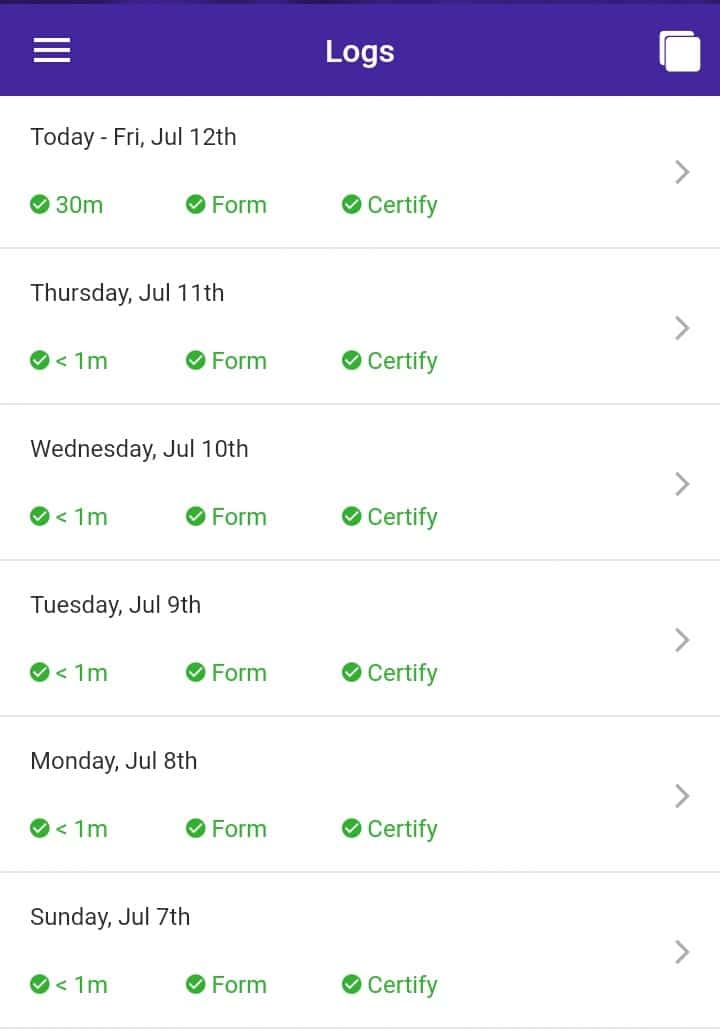The main reason truck drivers need an ELD is to comply with the truckers electronic log law and accurately record their HOS. Apart from compliance, an efficient electronic logbook should also be a helpful tool to streamline daily tasks and improve operations.
The Federal Motor Carrier Safety Administration’s list of approved devices is extensive and offers little practical information for carriers looking for a robust ELD service provider. In this article, we will help truckers get a better understanding of this law’s requirements and what HOS247 electronic logbooks bring to the table.
HOS Rules and Electronic Logbooks
Trucking accidents are a primary concern for transit authorities in the US. Driver fatigue caused by overwork threatens public safety on the road. That is why the FMCSA designed a mandatory truckers electronic log law that obliges drivers to comply with hours of service regulations.
Do you have any questions? Talk to ELD Advisor: 650-405-3372 or Request Callback
Hours of service refers to the time a driver can operate a commercial motor vehicle and be on duty. These requirements were established by the FMCSA decades ago, but the elog mandate’s implementation made it a requirement for most commercial vehicles to use an electronic logbook to record HOS.
The ELD is a technological advancement that comes as an alternative to the traditional paper logbooks or outdated automatic on-board recording devices (AOBRD). Elogs help operators keep an automatic and accurate record of their driving hours through a hardware piece that connects directly to the vehicle’s engine to record that information.
An elog system may have other features that optimize fleet performance and facilitate communication between the operator and fleet management, streamlining the administrative tasks.

Who Needs ELDs?
According to the truckers electronic log law, most motor carriers are required to use an electronic logging device in their commercial vehicles. The FMCSA rules apply to passenger- and property-carrying vehicles that travel across state lines—since they fall under federal jurisdiction—and to drivers domiciled in Mexico or Canada.
However, there are several exemptions from the ELD rule. What are these exemptions and under what circumstances can drivers manually record their hours of service?
- Short-haul exemption. Drivers who operate commercial vehicles within a 150-mile radius from their work location.
- Pre-2000 vehicles exemption. Drivers of vehicles with engines manufactured before the year 2000.
- Driveaway-towaway operations exemption. When the truck is the product being delivered.
- 8-day exemption. Drivers who keep RODS for at most 8 days during a thirty day period.
An important note: In case of ELD malfunction, drivers must keep their RODS on a paper log for up to eight days—the time given for the carrier to service, repair, or replace the device—to avoid noncompliance issues.
Are Elog Apps Compliant with the Truckers Electronic Log Law?
Since smartphones have now become an integral part of our lives, you might wonder whether an application would be enough to comply with the truckers electronic log law. There are a few things that you need to understand about using an app for your RODS.
In order to achieve compliance with the FMCSA mandate standards carrier companies are required to use an ELD that synchronizes with the vehicle engine control module to record the RODS details directly. An elog mobile app can be used as part of the ELD system to display the information, but without a certified electronic logging device that connects to the engine, it won’t be enough to comply with the truckers electronic log law.
While the FMCSA allows fleet companies to choose the electronic logging device of their preference amongst those in its approved list, it is essential to check that the elog complies with the ELD rule’s technical specifications.
HOS247 Is a Leading ELD Service Provider

- Efficient and responsive customer support team. We understand how valuable truckers’ time is. HOS247’s multilingual team of reps provides clients with efficient technical service from Monday through Sunday. Thanks to our callback policy, no customer will be left unattended: if the call gets interrupted, our support reps will reach out to you immediately.
- No contracts. We offer a flexible system of monthly or yearly subscription, so our clients are not locked in long-term contracts. You can easily scale your plan up or down or cancel it without paying any fines or penalties.
- 14-day trial. Before we take you on board, we want you to give you the chance to experience the services that HOS247 offers. Our two-week trial period allows customers to get to know the system and its perks to make sure it works out for them.
- Reliable hardware. Our hardware is durable and keeps accurate records. The steady Bluetooth connection makes sure the data is correctly transferred and displayed on the driver’s mobile device. In case of breakage, we offer a free replacement as per our one-year warranty policy.
- Driver-friendly interface. Using our ELD solution is easy. Operators don’t need training and their records can be easily managed so they can focus on driving.
HOS247 ELDs Support All HOS Rules and Exceptions
In order to stay compliant with the truckers electronic log law, it’s important to know the hours of service rules set by the FMCSA. These are the main time conditions commercial vehicle drivers have to be aware of while on duty:
- 14-hour “driving window”. The limit indicates the amount of hours drivers have in order to complete their day’s driving time. After 14 hours of being on duty, driving is not allowed. Drivers must take at least 10 consecutive hours off duty before driving again. For passenger-carrier drivers this limit is extended to 15 hours.
- 11-hour driving limit. The total amount of time property-carrying drivers are allowed to drive during their 14-hour work shift is 11 hours. To be able to drive again they will have to be off duty for 10 consecutive hours. Passenger-carrying drivers can drive a maximum of 10 hours after 8 consecutive hours off duty.
- 30-minute rest breaks. After driving for 8 consecutive hours, operators must take a break for 30 minutes. However, they can carry out non-driving tasks during the break.
- 60/70-hour limit. Driving is not allowed after completing a cycle of 70 hours in 8 days or 60 hours in 7 days. To restart the cycle, the driver must take at least 34 consecutive hours off duty.
- Sleeper berth provision. Time spent in the driver’s sleeper berth is counted as off-duty time. The mandatory 10-hour off-duty period can be split in shorter intervals, however the law requires drivers to spend in the sleeper berth at least 7 consecutive hours.

However, there are few scenarios that allow drivers to forgo these rules. This can happen in the following cases:
- 30-minute break rule exemption. Qualified short-distance drivers operating within a 150 air-mile radius of the normal work reporting location do not have to take a break.
- 16-hour short-haul exception. Truckers are allowed to extend the 14-hour driving restriction to 16 hours once every seven consecutive days if they meet these requirements:
- The driver checked out from the same work location as during the past five days.
- After being on duty for 16 hours, the driver is released from work.
- The driver has not applied the 16-hour short-haul exception in the previous six consecutive days. To restart the weekly cycle, truckers have to take a 34-hour off-duty break.
- Poor driving conditions. The operator can extend the driving time by two hours in case of adverse driving conditions, such as unforecasted bad weather, accidents on the road, and other incidents.
- Direct emergency assistance. Emergency conditions declared by the USA president, state governors, or the FMCSA can temporarily remove all HOS rules.
Reliable ELDs are preprogrammed according to these exceptions so motor carriers will maintain compliance with the truckers electronic log law even in unforeseen circumstances. HOS247 logging solutions support all updated HOS rules and exceptions and comply with FMCSA regulations, keeping accurate electronic logs for truckers.
Using our electronic logging system, drivers will be alerted before they cross maximum driving limits for commercial truckers. Book a free demo to check out if our services suit the needs of your business.

I’ve co-founded, built and managed several transportation-related businesses. Now, I’m a founder and CEO of HOS247 – an AI Transportation Platform for trucking companies, freight brokers and other logistics operations. We are transitioning old-style operations to technology-advanced logistics entities and help them to grow their businesses. ELDs (electronic logging devices), fleet tracking and management 2.0 combined with AI-powered dispatch tools.












Switching to a reliable ELDs HOS provider can help lower your costs, saving you both time, money, and other resources. You will be able to review real-time data that will allow you to keep track of every single vehicle in

In the world of commercial trucking, staying on top of regulations is key to smooth operations. The electronic logging device (ELD) mandate, enforced by the Federal Motor Carrier Safety Administration (FMCSA), has reshaped how drivers and carriers track hours of

User-friendly ELDs and accompanying apps are more important now than ever, as driver turnover continues to be a problem for trucking businesses. Difficult to navigate apps make drivers’ jobs more complicated. That is one more inconvenience that could make them